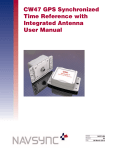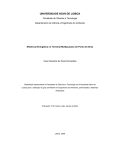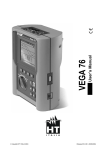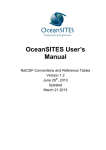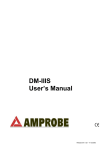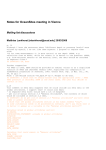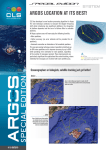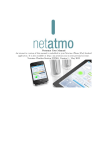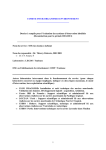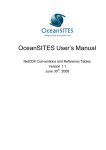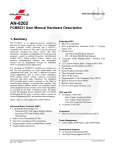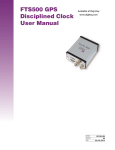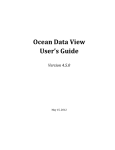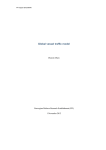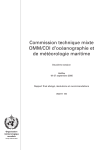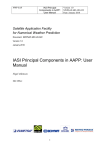Download J-TR-72-Data-Cookboo..
Transcript
World Meteorological Organization WORLD METEOROLOGICAL ORGANIZATION INTERGOVERNMENTAL OCEANOGRAPHIC COMMISSION (OF UNESCO) _____________ _____________ AN OCEANOGRAPHER’S AND MARINE METEOROLOGIST’S COOKBOOK FOR SUBMITTING DATA AND METADATA IN REALTIME AND IN DELAYED-MODE 2015 JCOMM Technical Report No. 72 [page left intentionally blank] WORLD METEOROLOGICAL ORGANIZATION _____________ INTERGOVERNMENTAL OCEANOGRAPHIC COMMISSION (OF UNESCO) ___________ AN OCEANOGRAPHER’S AND MARINE METEOROLOGIST’S COOKBOOK FOR SUBMITTING DATA AND METADATA IN REALTIME AND IN DELAYED-MODE JCOMM Technical Report No. 72 NOTES WMO DISCLAIMER Regulation 42 Recommendations of working groups shall have no status within the Organization until they have been approved by the responsible constituent body. In the case of joint working groups the recommendations must be concurred with by the presidents of the constituent bodies concerned before being submitted to the designated constituent body. Regulation 43 In the case of a recommendation made by a working group between sessions of the responsible constituent body, either in a session of a working group or by correspondence, the president of the body may, as an exceptional measure, approve the recommendation on behalf of the constituent body when the matter is, in his opinion, urgent, and does not appear to imply new obligations for Members. He may then submit this recommendation for adoption by the Executive Council or to the President of the Organization for action in accordance with Regulation 9(5). © World Meteorological Organization, 2015 The right of publication in print, electronic and any other form and in any language is reserved by WMO. Short extracts from WMO publications may be reproduced without authorization provided that the complete source is clearly indicated. Editorial correspondence and requests to publish, reproduce or translate this publication (articles) in part or in whole should be addressed to: Chairperson, Publications Board World Meteorological Organization (WMO) 7 bis, avenue de la Paix P.O. Box No. 2300 CH-1211 Geneva 2, Switzerland Tel.: +41 (0)22 730 84 03 Fax: +41 (0)22 730 80 40 E-mail: [email protected] IOC (OF UNESCO) DISCLAIMER The designations employed and the presentation of material in this publication do not imply the expression of any opinion whatsoever on the part of the Secretariats of UNESCO and IOC concerning the legal status of any country or territory, or its authorities, or concerning the delimitation of the frontiers of any country or territory. ____________ -5- CONTENTS NOTES 4 WMO DISCLAIMER ........................................................................................................................................... 4 RECORD OF CHANGES .................................................................................................................................. 7 1. Introduction ...................................................................................................................................... 9 2. Overview of Data Types Covered in the Document ........................................................................ 9 2.1 Marine Meteorological Data Sets .......................................................................................................... 10 2.1.1 Ships ........................................................................................................................................ 10 2.1.2 Moored buoys .......................................................................................................................... 10 2.1.3 Drifting buoys ........................................................................................................................... 10 2.2 Offshore rigs and platforms; and coastal observations ......................................................................... 11 2.2.1 Oceanographic Data Sets ........................................................................................................ 11 2.2.2 Ships ........................................................................................................................................ 11 2.2.3 Moored Buoys .......................................................................................................................... 11 2.2.4 Drifting Buoys........................................................................................................................... 11 2.2.5 Profiling Floats (and gliders) .................................................................................................... 12 3. Overview of Activities Seeking Real-time Data Inputs .................................................................. 12 4. Overview of Activities Seeking Delayed-mode Data Inputs .......................................................... 12 5. Primer of Data Formats ................................................................................................................. 12 5.1 Real-time Data....................................................................................................................................... 12 5.2 Delayed-mode Data............................................................................................................................... 13 6. Real-time Oceanographic and Marine Meteorological Data Submission Pathways &Protocols ... 13 6.1 General Information ............................................................................................................................... 13 6.1.1 What is the GTS? .................................................................................................................... 13 6.1.2 How does the GTS work? ........................................................................................................ 13 6.1.3 What observations should or can go to the GTS? ................................................................... 14 6.1.4 How do data get onto the GTS? .............................................................................................. 14 6.1.5 How fast do observations need to get to the GTS? ................................................................. 14 6.1.6 Who do I contact? .................................................................................................................... 14 6.1.7 What about data quality? ......................................................................................................... 14 6.2 Moving data to the GTS ........................................................................................................................ 15 6.2.1 Getting data ashore. ................................................................................................................ 15 6.2.2 What to do after the data are ashore? ..................................................................................... 15 6.2.3 Who do I talk to for help? ......................................................................................................... 15 6.3 Getting data from the GTS .................................................................................................................... 16 7. Delayed-mode Oceanographic and Marine Meteorological Data Submission Pathways and Protocols ........................................................................................................................................ 16 8. Cookbook 1: Recipes for Submitting Marine Meteorological Data in Real-time........................... 18 Recipe 1: VOS ............................................................................................................................................ 18 Recipe 2: Research Ship ............................................................................................................................ 20 Recipe 3: Naval Vessel ............................................................................................................................... 20 Recipe 4: Moored Buoy and Drifting Buoy with Argos Telemetry .............................................................. 20 Recipe 5: Moored Buoy and Drifting Buoy with Iridium Telemetry ............................................................. 21 9. Cookbook 2: Recipes for Submitting Marine Meteorological Data in Delayed-Mode................... 21 Recipe 1: Moored Buoy............................................................................................................................... 21 Recipe 2: Drifting Buoy ............................................................................................................................... 22 Recipe 3: VOS ............................................................................................................................................ 22 Recipe 4: Research Ship ............................................................................................................................ 22 Recipe 5: Naval Vessel ............................................................................................................................... 23 10. Cookbook 3: Recipes for Submitting Oceanographic Data in Real-time...................................... 24 Recipe 1: Lowered Instrument (CTD, Bottle, XBT, etc.) Data .................................................................... 24 Recipe 2: Profiling Float Data via Argos or National Systems .................................................................... 24 Recipe 3: Profiling Float Data via Iridium .................................................................................................... 25 Recipe 4: Moored Buoy Data via Argos ...................................................................................................... 25 Recipe 5: Moored Buoy Data via Iridium .................................................................................................... 26 Recipe 6: Drifting Buoy Data via Argos ....................................................................................................... 27 Recipe 7: Drifting Buoy Data via Iridium ..................................................................................................... 27 Recipe 8: Data via National Services .......................................................................................................... 27 11. Cookbook 4: Recipes for Submitting Oceanographic Data in Delayed-mode.............................. 28 Recipe 1: Lowered Instrument (CTD, Bottle, XBT, etc.) Data .................................................................... 28 Recipe 2: Profiling Float Data ..................................................................................................................... 28 -6Recipe 3: Moored Buoy Data ...................................................................................................................... 29 Recipe 4: Drifting Buoy Data ....................................................................................................................... 29 -7- RECORD OF CHANGES Version No Date 0.1 -0.5 2009-2013 0.6 0.7 Dec. 2013 Jan. 2014 0.8 Mar. 2015 1.0 Sept. 2015 Author(s)/Contributor (s) Robert Keeley, Hester Viola Kelly Stroker DMCG-5 Scott Woodruff, Champika Gallage Sissy Iona Change First drafts which involved wide consultation within JCOMM Refinement of the cookbook Review by DMCG-5 Refinement and content review First version approved by DMCG Chair -8- FOREWORD There are many marine meteorological and oceanographic (met-ocean) observations which are not currently contributing to WMO and IOC Applications. Several reasons may explain the situation, including for example reluctance to make the data available due to data policies conflicting with the WMO and IOC ones, requirement for publishing scientific results based on the data before allowing data distribution, or lack of confidence in the data quality. However, in some cases, the data are simply not distributed because of the perceived complexity or lack of understanding of the platform operators and programme managers concerning the data systems, mechanisms, protocols and formats required in the WMO and IOC frameworks to achieve such exchange of the observations. The JCOMM Data Management Coordination Group (DMCG) identified a need to produce an Oceanographers’ and Marine Meteorologists’ Cookbook for Submitting Data and Metadata in Realtime and Delayed Mode, the “Cookbook”. Its purpose is to provide the potential data providers with a complete and simple description of what’s required to practically achieve the real-time and delayed mode exchange of met-ocean observations, together with the required observing platform and instrument metadata, through the appropriate data systems promoted by JCOMM, such as the WMO Information System (WIS) and its Global Telecommunication System (GTS), or the various Global Data Acquisition or Assembly Centres (GDACs) operated for specific ocean observing networks. The focus of the “Cookbook” is on in situ, directly observed measurements, rather than on remote sensing data (e.g. from satellites). The “Cookbook” documents the widely varying methods of submitting data and metadata in-real time and delayed-mode from all types of metocean observing platforms that contribute to JCOMM. Other types of data such as those of Automated Underwater Vehicles (AUVs) or animal tags are not yet addressed in this cookbook. The users of the “Cookbook” are met-ocean observing platform operators. For example, the Data Buoy Cooperation (DBCP) Panel has a diverse community; platform operators, program managers, data users, model developers, platform manufactures, telecommunication service providers, to name a few who facilitate to operate variety of platforms and provide data to the Global Telecommunication System for broader public use. The “Cookbook” was prepared by the DMCG with contributions from various actors and experts from the JCOMM Data Management (DMPA) and Observations Programme Areas (OPA). This is a living document and will be updated as required. The intent is to have frequent refreshes and additions to the document as users provide feedback and additional input. Some of the sections of this document are under construction and will be completed in due course. Sissy Iona (Greece) Chair, DMCG ____________ -9- AN OCEANOGRAPHER’S AND MARINE METEOROLOGIST’S COOKBOOK FOR SUBMITTING DATA AND METADATA IN REAL-TIME AND IN DELAYED-MODE 1. Introduction A number of national, regional and international programmes are collecting oceanographic and marine meteorological data either in project-funded activities or in a monitoring mode. Some of these data are contributed to the international data systems and so become readily available either in real-time or delayedmode to other researchers. But, another fraction of these observations is accumulated in home institutions; these are delayed or sometimes never reach the international community. Those data that can be sent shortly after collection can contribute to real-time data exchange and thereby support the development of operational meteorological and oceanographic services. Those that arrive in delayed-mode help improve the fundamental national and international JCOMM archive databases such as the International Comprehensive Ocean-Atmosphere Data Set (ICOADS; http://icoads.noaa.gov) or World Ocean Database (WOD; http://www.nodc.noaa.gov/OC5/WOD/pr_wod.html) which in turn are used to develop climatology, extend time series, and contribute to assessments of climate change, among many other research and operational activities. Because of the paucity of marine data, all observations of acceptable quality are valuable. The intent of this document is to provide a practical resource to those who collect oceanographic and marine meteorological data to facilitate contribution of the data to the international community. The focus is on insitu, directly observed measurements, rather than on remote sensing data (e.g. from satellites). The approach taken here is to provide several brief, informative primers on the data types covered in this document, example activities that use the data, and then on the pathways and protocols for submitting data as well as the critical accompanying instrument-platform (I-P) metadata (see Snowden et al. 2010) both in real-time and in delayed-mode. These primers are followed by “cookbooks” that provide the detailed procedures to provide data and metadata. Some of the sections of this document are under development. This document will be maintained electronically with additions made as required. The intent is to have frequent refreshes and additions to the recipes as users provide feedback and additional inputs. Please send input via email to the DBCP Technical Coordinator at [email protected]. This document will be kept up to date and available on the JCOMM website at:www.jcomm.info/data-cookbook 2. Overview of Data Types Covered in the Document The cookbook is organized according to types of data (broadly marine meteorological or oceanographic) and the delivery time frame (real-time or delayed-mode). Each is then subdivided into recipes that address specific platform types and/ or instruments. The intention is that someone being encouraged to submit data and the associated I-P metadata can simply consult the appropriate recipe for the very practical details of what needs to be done and how. All of the platforms referenced can operate to deliver data in real-time (usually within minutes to days of the observation being made). In some cases, such as profiling floats, that is the sole mode of operation. Realtime data transmissions use coastal radio stations, email, web servers, Inmarsat, Argos, Iridium or satellite communication systems to provide all or a subset of data. Real-time data have limitations that need to be recognized. Because of telecommunications bandwidth or transmission costs, the high precision measurements of which the instruments are capable may not always be sent ashore for distribution. Whilst, instruments may sample at a very high frequency; they usually report an averaged quantity in real-time. Observations sent ashore in real-time may have errors due to instrument malfunction and drift, coding issues, telecommunications problems or human intervention errors. In making the data available quickly, it is usual to have automated data quality checking software looking for errors. These are not capable of finding the more subtle errors and so it is common for a higher error rate to be found in real-time data streams. In some modes of data collection, usually in research projects, instruments collect data at a higher sampling frequency than is reported in real-time, or at a higher precision. In these cases, the data are often stored onboard and returned to the operational centre at the end of the research cruise or voyage. The data then pass - 10 through delayed-mode processing to carry out calibrations, check for possible errors and form the subject of research. These delayed-mode data are of the highest quality, highest resolution data available. However, the delays in data reaching archives and becoming available to a wide user community can be months or even years. Another important form of delayed-mode data, which can become available on quicker timescales, is quality controlled collections of real-time receipts. 2.1 Marine Meteorological Data Sets Marine meteorological observations come from a variety of platforms. The following sections discuss characteristics of the major types. Higher sampling rate data may be stored on board and available for submission later in delayed-mode. This is true for research buoys, for example, that record surface meteorology as one-minute averages but do further averaging to produce one-hour averages for telemetry. 2.1.1 Ships Merchant ships that have been recruited to serve as Voluntary Observing Ships (VOS), naval and Coast Guard vessels, research vessels (RVs), fishing vessels, sailing vessels and vessels of other national agencies collect observations that include wind speed and direction, air temperature, sea surface temperature (SST), barometric sea level pressure (SLP), at least one humidity variable (dew point, wet bulb, relative humidity or absolute humidity), cloud cover (type, amount, at different elevations), surface wave and swell, and sea ice. Some ships, particularly RVs, also report incoming shortwave or solar radiation, incoming longwave or infrared radiation. Several RVs, and an increasing number of VOS now also carry Automatic Weather Stations (AWS) that sample at high frequency and high precision, but importantly omitting visually observed variables (e.g. cloudiness). 2.1.2 Moored buoys National Meteorological Services (NMS) and diverse research programs maintain moored buoys for different periods of time to collect marine meteorological data. Examples include the Global Tropical Moored Buoy Array (GTMBA) moorings in the near equatorial Pacific, Atlantic, and Indian Oceans called TAO/TRITON, PIRATA, and RAMA, respectively. Some moorings within the GTMBA also are considered OceanSITES stations, and thus some data are management redundantly within the OceanSITES program, and separately (e.g. at NOAA/PMEL). Some nations (e.g. Canada, UK, USA) also maintain networks of coastal buoys that gather data at high frequency. All of these coastal data reach the national weather services. Ocean research programs also deploy moored platforms and in most cases these, too, record meteorological information. Presently, it is not the case that all of these data reach national agencies or international acquisition centers. Generally moreover, the stewardship of the real-time and delayed-mode data, and crucial accompanying I-P metadata, from moored buoy arrays is heavily fragmented, both nationally and internationally, e.g. OOPC (2014) states (in White Paper #13): “The record of the data and information management community for TPOS [Tropical Pacific Observing System] is strong but can be improved, in terms of efficiency, robustness and effectiveness.” In the longer-term therefore, it is planned that most of the moored buoy data will be managed and archived more effectively through the planned network of Data Assembly Centres (DACs) and Global Data Assembly Centres (GDACs) under the emerging new WMO-IOC Marine Climate Data System (MCDS). The observation regime is one in which instruments are operated automatically and often for extended periods of time. Data are typically transferred ashore through telecommunications systems, usually by satellite systems, but also by UHF radio transmission for coastal buoys. 2.1.3 Drifting buoys Surface drifters have been in large-scale use since the early 1980s. The majority report a suite of atmospheric variables including air temperature, air pressure, and pressure tendency. They are also used for measuring currents and some are also capable of measuring wind speed, wind direction and salinity. The deployment and operation of the data collection in the open ocean from drifting (and moored) buoys are overseen by the JCOMM Data Buoy Cooperation Panel (DBCP). This group is an affiliation of operators, - 11 promotes standards for data formats, works to improve instrumentation, coordinates deployments to achieve global coverage, and serves a number of other functions. There are also other drifter deployments, usually for short time scale operations such as for search and rescue or targeted research. While the pathways for global distribution of data collections overseen by DBCP are well established and functioning, in many cases there are no pathways for the short time scale operations. 2.2 Offshore rigs and platforms; and coastal observations Offshore installations which can include both fixed oil and gas platforms and mobile drilling rigs also can contribute substantial volumes of meteorological data to the international system. These installations are often equipped by their operators with AWS systems to provide high quality meteorological data for the helicopters that serve them. Coastlines of some maritime countries (e.g. UK and USA) are populated with coastal meteorological and oceanographic automated reporting stations. For example, since the early 1980s NOAA’s National Data Buoy Center (NDBC) has been operating its Coastal-Marine Automated Network (C-MAN), now consisting of around 50 stations e.g. on near shore islands, and offshore platforms. Surface meteorological observations from the international tide gauge station network can also form an additional data source in this category. 2.2.1 Oceanographic Data Sets Oceanographic observations are made from ships, moored buoys, drifting buoys, and from profiling floats (including ocean gliders). Higher sampling rate data may be stored on board and available for submission later in delayed-mode. This is true for research ships, for example, that record sea temperature profiles at 1m or better resolution, but report data in real-time only at inflection points in the profile. 2.2.2 Ships Merchant ships that contribute to the Ship Of Opportunity Programme (SOOP), naval and Coast Guard vessels, RVs, fishing vessels, and vessels of other national agencies collect observations that include sea temperature, salinity, currents (speed and direction), dissolved oxygen, other chemical variables such as nutrients, information about pollutants such as oil, biological information such as types and abundance of fish or plankton, sea bottom types, etc. Though the range of variables collected by ships is large, the number of ships doing so is smaller than for meteorological variables. Research vessels play an important role in these observations since a large fraction of the data collected is from research cruises. 2.2.3 Moored Buoys Moored platforms collecting oceanographic information may be operated by NMSs or diverse research programmes. The buoys operated by national agencies often are maintained for extended periods of time, while those for research purposes may function for the life of the project only. Buoy instrumentation may record seawater properties as well as information on currents and waves. The open ocean moorings in the equatorial oceans often use sub-surface instruments to report ocean temperature and sometimes salinity profiles. Coastal buoys may collect other information including currents, light levels at different depths, particle counters, etc. Many of these gather data at high frequency but report averaged quantities in realtime. Additionally, OceanSITES is a worldwide system of long-term, deep-water, usually moored, reference stations typically measuring dozens of variables (both surface met. and oceanographic) and monitoring the full depth of the ocean, from air-sea interactions down to 5,000 meters. The observation regime is one in which instruments are operated automatically and often for extended periods of time. Data are typically transferred ashore through telecommunications systems, often satellite systems. 2.2.4 Drifting Buoys In addition to atmospheric variables, surface drifters also report SSTs. Some are also deployed with subsurface instrumentation that measures usually temperature and sometimes salinity. - 12 The deployment and operation of the data collection in the open ocean are overseen by the DBCP.. 2.2.5 Profiling Floats (and gliders) The recent developments of mass produced, standard models of autonomous profiling floats (Argo programme floats) has opened a new chapter in ocean observations. These profiling instruments are able to descend to about 2000m and ascend to the surface on a predetermined schedule sampling temperature, salinity, and, occasionally, other water properties. Gliders are outfitted with wings that allow them to direct their movements during ascent and descent to a degree. These instruments can operate unaided for years. Newer models are being tested that permit twoway communications so that on-board programming can be altered to change the characteristics of the sampling. 3. Overview of Activities Seeking Real-time Data Inputs There are two reasons to encourage real-time data inputs. The first is simply as a way to make data available as quickly as possible after collection to users who require them, as discussed below. The second is that data reported in real-time act as a notification of a data collection activity from which, in most cases, delayed-mode data may be expected. It is a way for the international data system to be aware on a large scale about data collection activities taking place, without necessarily direct involvement in each and every program. The clients for real-time data include the operational meteorological and oceanographic communities, as well as weather and climate researchers. These groups, epitomized by national weather centre’s, use in-situ observations as input to computer models. Models are used to fill in gaps in the observations to show both the current and predicted state of the ocean and atmosphere. The predictions can be from short time scales of hours to days, to seasonal or longer. More and more meteorological models are being connected to oceanographic models and in-situ data keep the models aligned with reality. Real-time data are used directly in hazard warning or mitigation situations. For example, real-time sea level observations are used to gauge the level of possible flooding, or to ensure the safety of shipping. 4. Overview of Activities Seeking Delayed-mode Data Inputs Delayed-mode data are used in many different circumstances. Because of their high quality and high resolution, they form the backbone of research. Together with the real-time data, they contribute to the assembly of widely used global climate databases such as ICOADS and WOD, which then in turn provide critical inputs for analyses of trends over time and to the formulation of climatology. Climatology has many uses; they provide the ability to assess recent observations, and assist in preparing data for ingestion by models. Delayed-mode data are also of importance in calibrating real-time observations. In the Argo program, for example, high quality, delayed-mode temperature and salinity observations from CTDs are used to assess the real-time data collected by profiling floats and to make adjustments for instrument drift. These are crucial for finding the more subtle errors in float data. Modelers often will carry out re-analyses of historical data to build reference data sets. These make use of the high-quality delayed-mode data that have, to the extent possible, replaced or supplemented the real-time observations. These can be particularly valuable in assessing extreme events and developing better performing models. 5. Primer of Data Formats 5.1 Real-time Data Virtually every instrument making observations produces data with a unique structure. In order for these to be usable, the data must be converted to more general formats. Unfortunately there is no single standard for data delivery. However the most well controlled deliveries are those associated with real-time data. - 13 Most oceanographic and meteorological data delivered in real-time are reported through the Global Telecommunications System (GTS) operated by the World Meteorological Organization (WMO). There are two types of data structures for reporting data. The older form is called Traditional Alphanumeric Codes (TACs). These are character-based forms, whose structures are rigidly set and maintained by WMO committees. They have been in operation for decades. A comprehensive list of these is provided by WMO (see Manual on Codes at: http://www.wmo.int/pages/prog/www/WMOCodes.html#Operational. Although TACs are relatively easy to learn, they are fairly inflexible to changing requirements, and place a heavy maintenance burden on encode and decode software. TACs are being phased out by WMO in favour of Table Driven Codes (TDCs). The earliest TDC version, called Binary Universal Form for the Representation of meteorological data (BUFR), is based on a number of tables listing variables and setting the number of bits used to send the information. A character form, called CREX, was developed later (See the same URL as above but reference BUFR). The advantage of BUFR is that a simple addition to a BUFR table allows new variables to be reported. This is a much simpler and flexible process than available for TACs. It is becoming popular to report data in real-time through the Internet by placing updates on web sites. Other technologies also exist that allow data to be sent through a subscription-like service, or for users to regularly pull data from a site where data are made available. Data made available this way are often available only to restricted audiences. In a redevelopment of its data transmission systems the WMO Information System (WIS) will support GTS-like operations for time-critical data and also support request-reply operations for data that have less time-critical characteristics. Since this is only developing at this stage, no more will be mentioned of WIS in this cookbook. 5.2 Delayed-mode Data Delayed-mode data appear in data structures that are nearly as varied as those delivered from instruments. Depending on operations of archive centres, they may be flexible in accepting data in many data structures, or more rigid and require data to arrive in only a few. There has been little success in standardizing these operations. In terms of distributing delayed-mode data, recent years have shown some convergence. Within the meteorological community, GRIB is used to exchange gridded fields. In oceanography, netCDF is beginning to be popular for gridded fields and is also used to exchange and archive “point” observations (e.g. many buoy data), though it is arguably not as well suited to this purpose. For marine meteorology, the data system designed to archive and distribute delayed-mode data from Voluntary Observing Ships (VOS) is the International Marine Meteorological Tape (IMMT) format (JCOMM 2012). Also, the International Maritime Meteorological Archive (IMMA; Woodruff 2007) is widely used within ICOADS to manage and archive marine meteorological data. 6. Real-time Oceanographic and Marine Meteorological Data Submission Pathways and Protocols 6.1 General Information 6.1.1 What is the GTS? The Global Telecommunications System (GTS) is the communications network operated collectively by NMSs, and with the overall rules and regulations of its operation governed by WMO. It is the network by which most of the meteorological data that are collected by nations are exchanged between countries around the world. It is the chief source of data that are used in the national weather prediction (NWP) models operated by many NMSs. 6.1.2 How does the GTS work? - 14 Data are bundled singly or multiply into bulletins. These have a prescribed structure that must be met. For data transmitted in character codes, the structure of the bulletin conveys some information about what kind of data are contained inside, and from what region of the world the data originate. Data sent in binary form travel on the GTS under different bulletins that convey different information from the bulletins carrying character codes. For oceanographers, it is simplest to talk to the local meteorological contact to get advice. 6.1.3 What observations should or can go to the GTS? There is a large suite of meteorological variables that can be sent on the GTS even in the older character code forms. Table driven code forms allow for even more observed variables, and additional information (I-P metadata) about the sampling instruments being used. They also allow higher data resolution data to be shared via the GTS, Oceanographic data may be sent in a more limited set of older character code forms and a very limited number of variables are handled. The table driven code forms permit more variables to be sent. The URL given in section 5.1 provides comprehensive lists of variables allowed on the GTS. 6.1.4 How do data get onto the GTS? Typically, only NMSs have direct access to the GTS. Therefore, to get data onto the GTS, an arrangement has to be made with your country’s meteorological service to allow you to provide data that they insert onto the GTS on your behalf. Arrangements are different in each country, but data always are inserted onto the GTS only by the NMS. 6.1.5 How fast do observations need to get to the GTS? Meteorological observations are usually inserted onto the GTS as soon as possible after measurement. Since they are used by many countries in NWP, the most recent data are extremely important for input to the models. For oceanographic purposes, there is an agreement that observations up to 30 days old can go onto the GTS. This delay period represents a common understanding of the time utility of observations contributing to real-time operations. In recent years, there has been both an emphasis on getting data distributed more quickly and success in doing this. The idea is to provide the data as soon as they are available and in good time so that they are available for ingestion into the forecast model runs. 6.1.6 Who do I contact? If you are intending to transform observational data into either TACs or TDCs, you will need to make contact with your country's national meteorological service to find out how to physically move the data to them, to determine what help they can provide in transforming your data into GTS compliant forms, to verify that your messages were built correctly, to get their advice on what bulletins should contain the data, and perhaps other considerations as well. 6.1.7 What about data quality? Sometimes data will be inserted onto the GTS with no checking of data quality having been carried out. However for most observations some quality checking will take place. In most cases, the quality checking is done quickly, and often using automated procedures. For this reason, the quality of data on the GTS cannot be considered as good as would be the case if more time were available. Because of the time constraint, it is not always possible to carry out instrument calibrations, corrections to times for clock errors, or more than the most rudimentary position checks. In most of the TACs, there is no way to indicate the quality of the data being distributed on the GTS. Where quality control is carried out, observations that fail the tests are usually removed from the data stream going to the GTS. - 15 If TDCs forms are used, it is possible to send both the observations and quality indicators. Data providers may choose to remove measurements that fail tests or simply set a quality flag indicating their poor quality, but send the complete set of measurements made. Users of real-time data realise that they are sometimes trading high accuracy for timeliness. 6.2 Moving data to the GTS 6.2.1 Getting data ashore. The data should come from the marine observing platform as quickly as possible. In some cases, the data come ashore through a telecommunications system such as Argos, Iridium, Inmarsat, or using a satellite-based internet connection and a transfer protocol like email or ftp. Meteorological data that do not get distributed on the GTS within a few hours of observation are often ignored by numerical weather prediction centres, (but will nevertheless be archived in climate databases). For oceanographic data, it may be more convenient or acceptable for a research cruise of short enough duration to bring all of the data ashore at the end of the cruise. While it is preferred to have the data distributed to the GTS in the shortest possible time after measurement, as long as the time between oceanographic observations and placing on the GTS is less than 30 days, the data are valuable in realtime. It is often the case that some reduction in resolution (either the precision of the measurement, or the spatial or temporal resolution) is done. Often this is to reduce the quantity of data that are sent through communications systems so as to reduce transmission costs to a land station. However, the GTS is capable of handling relatively high-resolution data, if they can be sent ashore. For example, sending XBT data at 1 m intervals from the surface to 800 m poses no difficulty for the GTS transmission. All code forms (TACs or TDCs) for ocean profiles have the ability to indicate if the depths reported for the observations are “selected” or “significant.” A profile with selected depths is one where the depths at which observations are reported are selected independently of the shape of the profile. A profile with significant depths has used some algorithm, such as the “broken pipe” method, to reduce the number of depths required while still reproducing the features of a profile to some pre-selected accuracy. 6.2.2 What to do after the data are ashore? For some kinds of data, such as from surface drifters that report using the Argos system, buoy operators need only give permission to CLS (Collect Localization Satellites), the Argos operator, to distribute their data on the GTS. Then, with the necessary information to decode the communication from the buoy itself, CLS takes care of the rest. In the case of iridium data is usually routed by email to the National Meteorological Services who then route the data onto the GTS. For other kinds of data, what you need to do depends on what facilities exist in your country. In some, the national ocean data centre will accept the data and do all of the necessary work to convert the data to the format required by the GTS. Normally they will also send the data to the national meteorological service for insertion onto the GTS. It is best to contact the data centre ahead of time to discuss formats for the data coming to the centre, and mechanisms to pass the data from the place where the data come ashore. In Canada, for example, the national oceanographic data centre accepts data arriving in an agreed email format, data already formatted to comply with GTS rules, or data sent in other formats. They convert the data to an internal data structure, pass them through a quality check, reformat to the appropriate TAC, send the data to the GTS and then monitor that the data were distributed on the GTS. In Australia, there is a similar process, but it is a shared oceanographic and meteorological service that performs the same function. Other countries have different capabilities. 6.2.3 Who do I talk to for help? If you don't know who to talk to in your own country, there are a couple of choices. If you have a national oceanographic data centre, contact them to find out what services they can offer (see URLs provided in section 7). Alternatively, you can contact the JCOMMOPS Technical Coordinators (with [email protected]). Although they may not know precisely whom you should contact, they will know the coordinator in your country, and that person should be a useful place to start. - 16 - 6.3 Getting data from the GTS If you are part of your NMS, you should already know what branch of your service manages GTS data. If you are outside of a national meteorological service, you should contact your NMS to ask if they can provide the data to you. You will need to discuss the format of the data extracted from the GTS and coming to you. You may need to write software to read the various data formats (see the descriptions above). It should be noted that there is some data that is considered sensitive for security or commercial reasons that cannot be made available outside of the national meteorological service. If you are interested in oceanographic data, another possibility is to talk to the national ocean data centre in Canada (http://www.meds-sdmm.dfo-mpo.gc.ca/meds/Contact_US/Request_e.asp). They already acquire all of the ocean profile data reported in TACs (BATHY and TESAC) as well as all surface drifter data (BUOY), and along track observations (TRACKOB) from everywhere in the world. These data are decoded, and combined into a consistent format, with quality control procedures applied and quality flags attached. For the profile data, files are produced 3 times a week and can be automatically forwarded to a user through an ftp process. Some wave data (WAVEOB) are reported on the GTS. If wave data are required, it is likely simpler to go to national wave data web sites rather than attempt to get the data from the GTS. 7. Delayed-mode Oceanographic and Marine Meteorological Data Submission Pathways and Protocols The international exchange of delayed-mode ocean data is coordinated through the International Oceanographic Data and Information Exchange (IODE, http://www.iode.org/) of the Intergovernmental Oceanographic Commission (IOC). The IODE system forms a worldwide network consisting of NODCs (National Oceanographic Data Centres), ADUs (Associate Data Units) and GDACs (Global Data Assembly Centres). Currently there are 81 NODCs and 16 ADUs in 81 countries (see http://www.iode.org/index.php?option=com_oe&task=viewGroupRecord&groupID=59. NODCs provide national points of contact for researchers to both provide data to and access data from international sources. Each NODC operates under national arrangements for the kinds of data they handle and how their operations are structured. Points of contact for each can be found at http://www.iode.org/index.php?option=com_oe&task=viewGroupRecord&groupID=60. Researchers wishing to contribute data should contact their national data centre first. Increasingly individual projects, programmes, and institutions establish their own data systems. This poses a risk for the loss of data if these projects or programmes are terminated or if individual scientists change jobs. In addition huge volumes of data managed this way do not reach the NODCs and are therefore not shared globally. To respond to this the IODE Committee, at its 22nd Session (2013) established the new structural element "The IODE Associated Data Unit". The current list of ADUs can be found at: http://www.iode.org/index.php?option=com_content&view=article&id=373&Itemid=100089 If a country does not have an NODC, contact can be made to the IODE Project Office established in Ostende, Belgium (http://www.iode.org/index.php?option=com_content&view=article&id=46&Itemid=84). The office manager can assist in making arrangements for transfer of the data to an appropriate archive centre. References JCOMM, 2012: Layout for the International Maritime Meteorological Tape (IMMT) Format IMMT-5 (Version 5) [http://www.wmo.int/pages/prog/amp/mmop/documents/IMMT-5-JCOMM-4.pdf]. OOPC, 2014: Report of the Tropical Pacific Observing System 2020 Workshop (TPOS 2020), 27-30th January 2014, Scripps Institution of Oceanography, San Diego. Vol. II–White Papers [http://www.jcomm.info/index.php?option=com_oe&task=viewDocumentRecord&docID=13217]. Snowden, D. & Co-Authors, 2010: Metadata Management in Global Distributed Ocean Observation Networks. In Proceedings of OceanObs’09: Sustained Ocean Observations and Information for Society (Vol. 2), Venice, Italy, 21-25 September 2009, Hall, J., Harrison, D.E. & Stammer, D., Eds., ESA Publication WPP-306, doi:10.5270/OceanObs09.cwp.84 - 17 WMO, 1955-: International List of Selected, Supplementary and Auxiliary Ships. WMO-No. 47. WMO: Geneva. (Serial publication; recently annual. Editions prior to 1966 were entitled International List of Selected and Supplementary Ships.) [http://www.wmo.int/pages/prog/www/ois/pub47/pub47-home.htm] Woodruff S.D., 2007: Archival of data other than in IMMT format: The International Maritime Meteorological Archive (IMMA) Format. Second Session of the JCOMM Expert Team on Marine Climatology (ETMC), Geneva, Switzerland, 26–27 March 2007, JCOMM Meeting Report No. 50, 68–101 (online under: http://icoads.noaa.gov/e-doc/imma/). - 18 - 8. Cookbook 1: Recipes for Submitting Marine Meteorological Data in Real-time Recipe 1: VOS The JCOMM Ship Observations Team (SOT) oversees the operations of Voluntary Observing Ships (VOS) that contribute to the International VOS Scheme (http://sot.jcommops.org/vos). VOS are primarily recruited by the National Meteorological Services to provide real-time data for their numerical forecast prediction models. Further details on how the VOS Scheme operates and on the different classes of VOS ship are given in Chapter 6 of WMO Publication no 471, available online at http://library.wmo.int/opac/index.php?lvl=notice_display&id=7469 VOS generally fall into one of the following two categories; Manually reporting VOS The following steps are necessary to ensure the efficient collection of real-time data Step 1 – Recruitment & Instrumentation Manually reporting ships are usually recruited to the VOS Scheme by a visiting national Port Meteorological Officer (PMO) who will instruct observers (usually the ships navigating officers) in the correct observing practices and install the necessary instrumentation for the collection of real-time data. A list of PMO contacts is maintained at http://www.jcomm.info/index.php?option=com_oe&task=viewGroupRecord&groupID=151 For most classes of VOS certified and calibrated instruments for taking real-time observations will be loaned to the ship by the national meteorological services. However for the ‘Auxiliary’ VOS class the ships own non-certified instruments can be used. . Most VOS will transmit their real-time data using their registered call sign assigned by the International Telecommunications Union (ITU). However in some cases for commercial or security reasons—the shipowner may request use of a “Masked” call sign so that the identity, and location, of a particular ship is not readily available to third parties. Masked call signs can be assigned in coordination with NMSs, on request, but are managed under JCOMM by the Ship Observations Team. An extra level of security for real-time messages will become available, called “Encode” when the BUFR code becomes fully operational will be implemented for VOS messages. Step 2- Coding of real-time VOS observations The vast majority of VOS now use electronic logbook software (e.g. TurboWin, AnmverSEAS or OBSJMA software) to encode their real-time observations. It therefore avoids the need for the observers to have a detailed knowledge of the codes, and can therefore concentrate on the observation itself. The logbook software is usually installed, with the prior agreement of the ships officers, on one of the ships computers. Approval by the shipowners IT department may therefore be necessary before installing the software. In some cases a dedicated notebook computer may be provided by the national meteorological service to overcome such problems. Typically the real-time observation is coded in a TAC format (e.g. WMO SHIP code) prior to transmission, although other compressed data formats are now being used by some meteorological services in order to reduce transmission costs. Step 3 – Real-time VOS Data transmission – Inmarsat C PMOs will advise on the most suitable method to transmit real-time VOS observations ashore. Because the majority of VOS are ocean-going merchant ships they are already required to carry dedicated Inmarsat communication systems on board for maritime distress and safety purposes. - 19 - Consequently the most VOS use their own Inmarsat C communication systems to transmit weather observations ashore. The coded observation compiled by the electronic logbook software is therefore transferred to the Inmarsat C equipment for transmission using Special Access Codes (SAC) which ensures that the costs are borne by the national meteorological service and not by the shipowner. SAC 41 is the code traditionally used by the majority of VOS, although new SAC codes dedicated to the national meteorological service that recruited the ship are now being used on some ships. These new SACs allow the data to be sent in a compressed format to reduce costs Observations sent via Inmarsat must be transmitted to an Inmarsat Land Earth Station (LES) that will accept SAC messages. Details of these LES are included in the electronic logbook software and are also available at http://www.wmo.int/pages/prog/amp/mmop/inmarsat_les.html . Having been received by the LES, the data are routed to the national meteorological service in the country that hosts the LES, who then insert the message on the GTS. With the migration to TDC codes this data will increasingly be encoded ashore by the national meteorological services so that they can be relayed on GTS in BUFR code Step 4 – Real-time VOS Data transmission – Email Many VOS shipowners or managers are now also willing to allow the weather observations to be sent using the ships email system, and consequently they bear the costs involved. Because the messages are small the costs are also usually very small, although costs will depend on the arrangements they have with their Inmarsat satellite providers. Because there is a risk that observations might be stored on board for transmission at prescribed times, or their being routed via data hubs ashore, great care must be taken to ensure that the observations are received in good time for the forecast model runs (typically no later than 120 minutes after being taken, but preferably as soon as possible after they are taken). In these cases the electronic logbook software automatically compiles the observed data into the email client ready for transmission and also applies the necessary GTS bulletin headers. This method is generally preferred by the ships officers as it avoids relaying the data to the ships dedicated Inmarsat C equipment. Step 4 – Real-time VOS Data transmission – Web interface As ships are increasingly having access to satellite broadband communications, a few VOS are now also using a dedicated website (TurboWeb) to send their real-time observations direct to servers in the National Meteorological Services. This approach has the advantage that any updates to the observing software can be introduced remotely without needing a PMO to visit the ship VOS equipped with Automatic Weather Stations In order to increase real-time data volumes and data quality many VOS operating countries are now moving away from the traditional manual compilation of weather reports by ships officers to installing dedicated Automatic Weather Stations (AWS). AWS systems rely on remote sensors and typically generate hourly real-time messages that are received and circulated on the GTS within minutes of their being taken. AWS systems are usually provided by the national meteorological services and will therefore require prior agreement from the ship owner or manager for the system to installed and maintained. There are a variety of systems currently being used but they generally fall into one of two categories; autonomous or integrated. Autonomous AWS Step 1 – Power requirements Autonomous AWS will usually only require a connection to the ships power supply, but if they are provided with solar power cells, this power connection will not be needed; so the systems are effectively plug and play. - 20 Step 2 – Data transmission Most autonomous systems now use the Iridium satellite system as it provides global coverage and provides very timely data. Because it also offers the possibility of two way communication Iridium allows the national Met service to remotely contact the AWS to update its configuration software. Some autonomous AWS still use the Argos system, but this system has comparatively poor data timeliness as the data must sometimes be stored on the satellite prior to transmission to a ground station. Step 3 – Instrumentation Autonomous systems typically report pressure, air temperature and humidity in real-time, but some can also be enhanced to also provide wind speed and direction and sea surface temperatures. Examples or autonomous AWS systems include MINOS, Automet, AUTOImet, AMOS etc Integrated AWS Step 1 – System requirements Integrated AWS systems generally require greater integration with the ships own systems e.g. connection to the ship gyro to facilitate wind direction measurements, or use of the ships cable runs to permit sea temperature readings from a hull sensor typically located below the water line in the ships engine room. Step 2 – Additional features Integrated AWS systems also have the facility to allow the onboard observers to manually add the visually observed elements to the outgoing real-time automated messages. Depending on the type of system used, data is usually transmitted via Inmarsat C or Iridium. Examples of Integrated AWS systems include AVOS, BATOS etc Recipe 2: Research Ship This section is under development. Recipe 3: Naval Vessel This section is under development. Recipe 4: Moored Buoy and Drifting Buoy with Argos Telemetry General Information: Section 7 provides information about the international system for managing ocean data. The links provided there will allow you to determine if your country has a point of contact, and where they are situated. The Data Buoy Cooperation Panel (DBCP: http://www.jcommops.org/dbcp/) oversees the operations of moored and drifting buoys. Anyone planning the deployment of a buoy must contact the chair of the Panel or the DBCP Technical Coordinator, available through the web address given above. Two centers process Argos data for distribution via the GTS: • United States Global Processing Center (USGPC) in Landover, Maryland, USA, • French Global Processing Center (FRGPC) in Toulouse, France. One of the goals of the system is to optimize the quantity and quality of Argos data sent onto the GTS without interfering with Principle Investigators' (PIs') requirements. Your Argos Service provider can forward data directly to GTS by prior arrangement. Contact User Services (at [email protected] and at [email protected] for the North American users) for a GTS Technical File, which will describe your buoy (location, etc) as well as the data stream (sensors, message fields) to enable Argos to decode the data and forward it to GTS. - 21 If for any reason your data can’t be decoded or processed by the Argos service provider, you can also make arrangements, in the US, for the National Data Buoy Center (NDBC) to submit your data. This must be arranged on a per-buoy basis by contacting NDBC at [email protected]. This process is documented on the NDBC website in the Frequently Asked Question section under "Observation Data from Other Providers" Recipe 5: Moored Buoy and Drifting Buoy with Iridium Telemetry General Information: Section 7 provides information about the international system for managing ocean data. The links provided there will allow you to determine if your country has a point of contact, and where they are situated. The Data Buoy Cooperation Panel (DBCP: http://www.jcommops.org/dbcp/) oversees the operations of moored buoys. Anyone planning the deployment of a moored buoy must contact the chair of the Panel or the DBCP Technical Coordinator, available through the web address given above. Most Iridium service providers do not offer the option to forward data to GTS, although CLS, the Argos system operator, which is now an Iridium Value Added Reseller (VAR), will now provide this service for data transmitted with Iridium service purchased through CLS. Contact User Services (at [email protected] and at [email protected] for the North American users) with all information available on your Iridium platform (user manual provided by the manufacturer, Iridium message data format, deployment location…) to enable CLS to decode the Iridium data and forward it to GTS For other Iridium users, it is possible to submit the data through your country’s DBCP National Focal Point (NFP). For the US, contact the National Data Buoy Center (NDBC) directly by email at [email protected]. The process is documented on their website in the Frequently Asked Question section under "Observation Data from Other Providers" The responsibility for basic quality control can be handled by the data provider or by the NFP. Step 1: Each national data centre operates under nationally set mandates and procedures. If you are planning to work with your NFP, contact them well ahead of your deployment and request information on their submission guidelines. They may assist you in acquiring a World Meteorological Organization (WMO) identifier for your buoy, provide guidance on which of your measurements are suitable for insertion into the GTS, and help ensure that you follow their conventions for these parameters. They will also be able to describe the data formats that they can accept, and provide you with a mechanism for submitting your data, usually in the form of an FTP server address and user account. Step 2: The NFP will request information about your data sources that will help ensure that it is used appropriately. Importantly this includes the instrumentation used, descriptions of how the instruments were deployed, the names of the measured variables, the units of measurement, the precision and accuracy of the measurements, their complete location (both horizontal and vertical dimensions), the relationship between the time value and the sample period of each parameter, details of any processing such as averaging, calibration, etc. that may have occurred, and so on. Any information that would be needed by someone else to correctly use the data should be provided. Step 3: The format and mechanism for data transport will be established. Different NFP agencies may have their own allowed formats for incoming data. The NDBC, for example, accepts data in BUFR and in two alternative formats. It also provides software to assist users in creating compliant files. Step 4: Once the data provider begins sending data to the NFP, the data should be monitored to ensure that any errors are found and corrected if possible. Any change in location of a moored buoy should also be reported immediately. If the NFP is providing QC services, they may inform the data provider of any problems seen; the data provider should likewise notify the NFP if problems are detected, if the buoy position changes, if instruments are replaced or if service interruptions are expected. Step 5: Submission of I-P metadata http://www.jcommops.org/dbcp/data/metadata.html) per new DBCP standard 9. Cookbook 2: Recipes for Submitting Marine Meteorological Data in Delayed-Mode Recipe 1: Moored Buoy (ref. - 22 - Internationally, as discussed above, the management of delayed-mode moored buoy data, and I-P metadata, presently is highly fragmented. Under the emerging new Marine Climate Data System (MCDS) however a variety of important improvements are planned. More information will available in future. Recipe 2: Drifting Buoy This section is under development. Recipe 3: VOS Although the emphasis of the VOS is primarily directed at real-time data collection, the data from manually reporting ships is also made available in delayed-mode. In particular, a subset of the VOS fleet called the VOS Climate (VOSClim) fleet, collects additional delayed-mode parameters that are included in a dedicated VOSClim dataset that is made available to climate researchers Step 1 – Coding of the delayed-mode data. Traditionally VOS data was collected using hardcopy meteorological logbooks that was subsequently collected ashore and manually digitized into the delayed-mode IMMT code format. Apart from a handful of ships this practice has now stopped and the overwhelming majority of data from manually reporting VOS is collected using electronic logbooks The use of electronic logbook software, such as TurboWin, allows the data to be encoded at source into the required delayed-mode IMMT format. Consequently, once the real-time observation has been completed and sent by the ships observer the data is automatically coded by the software into IMMT format. Similarly, integrated AWS systems that are installed on an increasing number of VOS usually include data loggers to allow the real-time observations to be automatically coded into delayed-mode IMMT format for subsequent collection Step 2 – Collection of the delayed-mode data. The delayed-mode VOS data collected in electronic logbooks can then be downloaded by the PMOs to a memory stick at routine inspection intervals or, alternatively, it can be emailed ashore by the on board observers. The software itself can also prompt the observers to perform routine data downloads. When the data is downloaded by a PMO care must be taken that data viruses are not transferred to or from the ships computers Similarly in the case of automated AWS systems that have a bridge display (e.g. BATOS, AVOS etc) facility is included to allow the PMO to download the delayed-mode data to a memory stick. Once the data is received by the national meteorological services it is added to their climate databases and quality controlled against the real-time VOS data. The VOS data is also relayed on to one of the two Global Collecting Centres (GCCs) who are tasked with ensuring that the data are received from contributing meteorological services around the world is processed to an agreed standard. The data are then distributed on a quarterly basis to eight responsible WMO members, each with their own area of responsibility. For further details see http://www.metoffice.gov.uk/weather/marine/observations/gathering_data/gcc.html Step 3 – Submission of Pub 47 metadata (ref. WMO 1955) This section is under development. Recipe 4: Research Ship This section is under development. - 23 Recipe 5: Naval Vessel This section is under development. - 24 - 10. Cookbook 3: Recipes for Submitting Oceanographic Data in Real-time Recipe 1: Lowered Instrument (CTD, Bottle, XBT, etc.) Data General Information: Measurements such as these made with in-situ instruments deployed from ships may require a multi-step process to get the data distributed in real-time. The JCOMM Ship Observation Team (see http://www.jcommops.org/sot/) coordinates activities for ships participating in the Ship Of Opportunity Programme (SOOP – see http://www.jcommops.org/sot/programmes.html#SOOP). There is much useful information at the SOOP web site even though the SOOP does not cover all platforms collecting data of this type. Step 1: In order to report data on the GTS, the ship must use an identifier called a call sign. This is assigned to a ship by each country with due notification provided to the ITU (International Telecommunication Union - http://www.itu.int). Each country has a member and this information is available from the ITU web site. They can help if you need to set the ship’s identification. Step 2: The data gathered on board the platform needs to be sent ashore. The ship can use the facilities promoted by the SOOP. To do so, refer to the section on “Telecommunications” at the SOOP web site. Alternatively, countries may choose to get data ashore through other methods. For example, in Canada, data collected from research vessels operated by the Canadian Government will sometimes send the data ashore through email. Alternatively, for cruises of short duration (shorter than the 30 day cut off for ocean data on the GTS), the cruise operator will bring the data back to port before any preparation for dissemination occurs. Step 3: After the data come ashore, they must be converted to the appropriate character code form (usually BATHY or TESAC) or into BUFR. If you use the facilities described at the SOOP web site, and the data go to a national meteorological centre, there should be nothing more to do. Consult with the SOOP Coordinator (on the SOOP web pages under “Participants and Contacts”). Step 4: If you choose not to use the facilities of SOOP, then you will need to make arrangements to convert the data into appropriate data formats for the GTS. These were generally described in section 5. If you are going to transform the data into TACs (character code forms) then you will need to look at the BATHY and TESAC code forms. Use the link given above to WMO and click on Manual on Codes, then Part A. Alphanumeric Codes. Alternatively, you can go to a web site maintained by Canada’s Integrated Science Data Management group (Canada’s ocean data archive) (see http://www.isdm-gdsi.gc.ca/isdmgdsi/gts-smt/index-eng.htm and click on the code form of interest). This latter site is not the official version, so if there should be any differences between information found at WMO and that found at ISDM, the authoritative source is WMO. If you are going to use BUFR, the same link given in section 5 takes you to the various pages describing BUFR. This is a significantly complicated code form and you are advised to consult with your national meteorological centre for advice. An initial point of contact could be to use your country’s SOT coordinator or the JCOMM contacts (see http://www.jcommops.org/contacts.html). Example: Over time Canada’s ocean data centre, ISDM, has assumed responsibility for coordinating the submission of ocean profile data from its research vessels to the GTS. The data are sent to ISDM, usually by email, and they carry out preliminary quality checking, format conversion and posting to the GTS through uploading of files to the meteorological agency in Canada who then place the data on the GTS. You can contact them through the “Services” link at http://www.meds-sdmm.dfompo.gc.ca/meds/Home_e.htm for more details. Recipe 2: Profiling Float Data via Argos or National Systems General information: The Argo programme is well coordinated internationally with the Argo Data Management Team managing all aspects of handling the data. For information about the programme itself see http://www.argo.ucsd.edu/index.html. For information about the data management component, see http://www.coriolis.eu.org//cdc/argo_rfc.htm. You should also read the Argo Data Management Handbook available at http://www.coriolis.eu.org/cdc/argo/argo_data_management_handbook.pdf. Step 1: Before your profiling floats can report data in real-time they need to be assigned a unique WMO identifier. Each country has been assigned a block of numbers and the country coordinator can provide - 25 identifiers for you. To see who is your country’s national coordinator for Argo see http://wo.jcommops.org/cgi-bin/WebObjects/Argo and choose “Contacts” then “Argo National Focal Points”. If your country has never deployed Argo floats before, contact the Argo Technical Coordinator at the same link. Note that these identifiers are never reused; when a float dies, its identifier dies with it. Step 2: CLS, the Argos operator, provides two services for profiling float operators. For the first service, they provide telecommunications facilities to relay data from the float to shore. In order to do this, your float must be equipped with an Argos transmitter and you must have an account at CLS. Consult the CLS user office at [email protected] and at [email protected] for the North American usersor speak to the Argo Technical coordinator through the Argo Information Centre (AIC) web site given in Step 1. Step 3: The second service offered by CLS is to decode the messages coming from your float, apply the standard Argo quality control tests, reformat to TESAC/BUFR code forms and insert the data onto the GTS. For details of how to initiate this, again speak to a representative from CLS or the Argo Technical Coordinator. If this is your choice, once you have made arrangements with CLS, you have nothing more to do to get the data distributed. Step 4: In addition to sending data to the GTS, CLS also will transform the data into the standard exchange format for Argo and forward the data to the Global Data Assembly Centers. These centres, one in France and one in the U.S.A., provide mirror sites where users can find Argo data. For more information about these centres, see the link in Step 1 describing the data management system. Step 5: Some countries choose to do their own processing of data received from the floats and take care of getting the data to the GTS. Your country may be one of these and so it is worthwhile talking to your Argo national coordinator (see Step 1). If your country does its own processing, the Argo National Focal Point will put you in touch with the processing facility. Recipe 3: Profiling Float Data via Iridium General information: The Argo programme is well coordinated internationally with the Argo Data Management Team managing all aspects of handling the data. For information about the programme itself see http://www.argo.ucsd.edu/index.html. For information about the data management component, see http://www.coriolis.eu.org//cdc/argo_rfc.htm. You should also read the Argo Data Management Handbook available at http://www.coriolis.eu.org/cdc/argo/argo_data_management_handbook.pdf. Step 1: Before your profiling floats can report data in real-time they need to be assigned a unique WMO identifier. Each country has been assigned a block of numbers and the country coordinator can provide identifiers for you. To see who is your country’s national coordinator for Argo see http://wo.jcommops.org/cgi-bin/WebObjects/Argo and choose “Contacts” then “Argo National Focal Points”. If your country has never deployed Argo floats before, contact the Argo Technical Coordinator at the same link. Note that these identifiers are never reused; when a float dies, its identifier dies with it. Step 2: Most Iridium service providers do not offer the option to forward data to GTS, although CLS, the Argos system operator, which is now an Iridium Value Added Reseller (VAR), will now provide this service for data transmitted with Iridium service purchased through CLS. Contact User Services (at [email protected] and at [email protected] for the North American users) with all information available on your Iridium platform (user manual provided by the manufacturer, Iridium message data format, deployment location…) to enable CLS to decode the Iridium data and forward it to GTS in TESAC and BUFR code forms. Step 3: In addition to sending data to the GTS, CLS also will transform the data into the standard exchange format for Argo and forward the data to the Global Data Assembly Centers. These centres, one in France and one in the U.S.A., provide mirror sites where users can find Argo data. For more information about these centres, see the link in Step 1 describing the data management system. Step 4: Some countries choose to do their own processing of data received from the floats and take care of getting the data to the GTS. Your country may be one of these and so it is worthwhile talking to your Argo national coordinator (see Step 1). If your country does its own processing, the Argo National Focal Point will put you in touch with the processing facility. Recipe 4: Moored Buoy Data via Argos - 26 General Information: The Data Buoy Cooperation Panel (DBCP: http://www.jcommops.org/dbcp/) oversees the operations of drifting buoys. Anyone contemplating deploying drifting buoys should contact the chair of the Panel or the DBCP Technical Coordinator available through the web address given above. Step 1: Before you can distribute data in real-time on the GTS, you must have a World Meteorological Organization (WMO) identifier given to your buoy. More explanation of what is a WMO identifier and how to get one is provided at http://www.jcommops.org/wmo_numbers.html. If this is unavailable, you can contact the DBCP Coordinator at the link provided above. Step 2: When CLS, the Argos system operator manages the insertion of the data onto the GTS, a buoy operator needs to provide sufficient information to tell them how to extract the data from the message sent by the PTT. CLS then configures their decoder to be able to read the data transmission from the buoy to extract the observations made, reformat the data to appear on the GTS in both BUOY code (a character code form) and BUFR (the binary code form). Recipe 5: Moored Buoy Data via Iridium General Information: Section 7 provides information about the international system for managing ocean data. The links provided there will allow you to determine if your country has a point of contact, and where they are situated. The Data Buoy Cooperation Panel (DBCP: http://www.jcommops.org/dbcp/) oversees the operations of moored buoys. Anyone planning the deployment of a moored buoy should contact the chair of the Panel or the DBCP Technical Coordinator, available through the web address given above. Most Iridium service providers do not offer the option to forward data to GTS, although CLS is providing now this service. For those who purchase Iridium service through CLS, obtain a form (GTS Technical File) at your User Office User Services (at [email protected] and at [email protected] for the North American users) which will provide sufficient information for CLS to extract the data from the Iridium message. CLS then configures their decoder to be able to read the data transmission from the buoy to extract the observations made, reformat the data to appear on the GTS. For those using other Iridium service providers, it is possible to make arrangements with your country’s DBCP National Focal Point (NFP) to submit the data for you. For the US, this is the National Data Buoy Center (NDBC). Data is typically sent from the buoy to the operator’s shore-side processing center using one of several Iridium modes, often Short Burst Messaging (SBD), which delivers data as an email attachment, to be processed locally, based on the contents of the payload. The operator adds a step to the local processing system to create a file with new data to be sent via ftp to the NFP. The responsibility for basic quality control can be handled by the data provider or by the NFP. Step 1: Each national data centre operates under nationally set mandates and procedures. If you are planning to work with your NFP, contact them well ahead of your deployment and request information on their submission guidelines. They may assist you in acquiring a World Meteorological Organization (WMO) identifier for your buoy, provide guidance on which of your measurements are suitable for insertion into the GTS, and help ensure that you follow their conventions for these parameters. They will also be able to describe the data formats that they can accept, and provide you with a mechanism for submitting your data, usually in the form of an FTP server address and user account. Step 2: The NFP will request information about your data sources that will help ensure that it is used appropriately. Important metadata includes the instrumentation used, descriptions of how the instruments were deployed, the names of the measured variables, the units of measurement, the precision and accuracy of the measurements, their complete location (both horizontal and vertical dimensions), the relationship between the time value and the sample period of each parameter, details of any processing such as averaging, calibration, etc. that may have occurred, and so on. Any information that would be needed by someone else to correctly use the data should be provided. Step 3: The format and mechanism for data transport will be established. Different NFP agencies may have their own allowed formats for incoming data. The NDBC, for example, accepts data in BUFR and in two alternative formats. It also provides software to assist users in creating compliant files. - 27 Step 4: Once the data provider begins sending data to the NFP, the data should be monitored to ensure that any errors are found and corrected if possible. Any change in location of a moored buoy should also be reported immediately. If the NFP is providing QC services, they may inform the data provider of any problems seen; the data provider should likewise notify the NFP if problems are detected, if the buoy position changes, if instruments are replaced or if service interruptions are expected. Recipe 6: Drifting Buoy Data via Argos General Information: The Data Buoy Cooperation Panel (DBCP: http://www.jcommops.org/dbcp/) oversees the operations of drifting buoys. Anyone contemplating deploying drifting buoys should contact the chair of the Panel or the DBCP Technical Coordinator available through the web address given above. Step 1: Before you can distribute data in real-time on the GTS, you must have a World Meteorological Organization (WMO) identifier given to your buoy. More explanation of what is a WMO identifier and how to get one is provided at http://www.jcommops.org/wmo_numbers.html. If this is unavailable, you can contact the DBCP Coordinator at the link provided above. Step 2: When CLS manages the insertion of the data onto the GTS, a buoy operator needs to provide sufficient information to tell them how to extract the data from the message sent by the PTT. CLS then configures their decoder to be able to read the data transmission from the buoy to extract the observations made, reformat the data to appear on the GTS in both BUOY code (a character code form) and BUFR (the binary code form). Recipe 7: Drifting Buoy Data via Iridium General Information: The Data Buoy Cooperation Panel (DBCP: http://www.jcommops.org/dbcp/) oversees the operations of drifting buoys. Anyone contemplating deploying drifting buoys should contact the chair of the Panel or the DBCP Technical Coordinator available through the web address given above. Step 1: Before you can distribute data in real-time on the GTS, you must have a World Meteorological Organization (WMO) identifier given to your buoy. More explanation of what is a WMO identifier and how to get one is provided at http://www.jcommops.org/wmo_numbers.html. If this is unavailable, you can contact the DBCP Coordinator at the link provided above. Step 2: Most Iridium service providers do not offer the option to forward data to GTS, although CLS and JouBeh Technologies are providing this service. For those who purchase Iridium service through CLS, obtain a form (GTS Technical File) at your User Office User Services (at [email protected] and at [email protected] for the North American users) which will provide sufficient information for CLS to extract the data from the Iridium message. CLS then configures their decoder to be able to read the data transmission from the buoy to extract the observations made, reformat the data to appear on the GTS. When CLS manages the insertion of the data onto the GTS, a buoy operator needs to provide sufficient information to tell them how to extract the data from the message sent by the Iridium drifting buoy. CLS then configures their decoder to be able to read the data transmission from the buoy to extract the observations made, reformat the data to appear on the GTS in both BUOY code (a character code form) and BUFR (the binary code form). Recipe 8: Data via National Services Some countries prefer to manage sending data in real-time through their own national services rather than commercial services. Examples of this can be found in the Argo programme (managing profiling float data) where some countries have built their own processing capabilities to receive data through the telecommunications facility that manages getting data from the float to shore (either Argos, Iridium, or whatever other means they have). In these cases, national services are responsible for all of the processing including creating the TESAC (soon to be BUFR) message type. Contact your national weather service or national ocean data centre to see what capabilities they have. - 28 - 11. Cookbook 4: Recipes for Submitting Oceanographic Data in Delayed-mode. Recipe 1: Lowered Instrument (CTD, Bottle, XBT, etc.) Data General information: Section 7 provides information about the international system for managing ocean data. The links provided there will allow you to determine if your country has a point of contact, and where they are situated. Step 1: Each national data centre operates under nationally set mandates and procedures. After contact is made, they will explain what are the procedures for submitting data to the centre and what they do with the data that are received. Some centres accept data in a limited number of formats and others are more liberal. The first step is to determine what data formats are mutually acceptable and by what means the data can be moved. Step 2: Data centres are sensitive to the needs to protect data from general distribution in some cases and for some period of time. Many countries have policies to govern this aspect. It is important to ask about these policies if you are concerned about immediate redistribution of the data you provide. Step 3: If it is important in the future to be able to identify the data as collected in the context of a particular project or some other association, then inform the data centre that this is a requirement and ensure that they know the correct term to attach to the data. Step 4: Once data have been delivered to a data centre, they will “unpack” what was sent. They will looking to be sure that information that is needed by others to interpret the data has accompanied the data. Some centres will also pass the data through procedures to look for unusual values. If they find information is missing, or some unusual measurements, they will come back to talk to you to resolve the questions. The type of information that is important to have includes the instrumentation used, descriptions of how the instruments were deployed, the names of the measured variables, the units of measurement, the precision and accuracy of the measurements, their complete location (both horizontal and vertical dimensions) and precise time, details of any processing such as averaging, calibration, etc. that may have occurred, and so on. Whatever information is needed by someone else to correctly use the data should be provided. Step 5: If for some reason your national centre is unable to manage the data you wish to provide, the next point of contact should be one of the World Data Centres: WDC for Oceanography, Silver Spring, United States (http://www.nodc.noaa.gov/worlddatacenter/) WDC for Marine Environmental Science, Bremen, Germany (http://www.pangaea.de/) WDC for Oceanography, Obninsk , Russian Federation (http://meteo.ru/nodc/index_e.html) WDC for Oceanography, Tianjin , People's Republic of China (http://wdcd.coi.gov.cn/english/eindex.html), which are now being incorporated into the new ICSU World Data System (WDS) (http://www.icsuwds.org/). They operate in similar ways to national centres and so you will have the same basic steps to follow as described above. Recipe 2: Profiling Float Data General Information: The only data returned from profiling floats comes through telecommunications facilities and so the data received in real-time are the only data received. However, in applying the real-time quality control procedures, some measurements may be excluded from real-time distribution. As well, the data reported on the GTS in TESAC code form may have a lower precision than is available from the instruments. Step 1: Each country is responsible for ensuring data from their profiling floats pass through delayed-mode quality control procedures agreed to by the Argo Data Management Team and the Argo Steering Team. These procedures are described at http://www.coriolis.eu.org/Documentation/General-Informations-onData/Formats-QCs. After this is completed, the data should be submitted to the Argo Global Data Assembly Centers. Step 2: If your country already has a processing facility for real-time data, then it is possible that they also carry out the delayed-mode quality control as well. If they do not, they will know who carries out this function for your country. Consult your Argo National Focal Point (see http://wo.jcommops.org/cgi- - 29 bin/WebObjects/Argo and choose “Contacts” then “Argo National Focal Points”) or your national data management contact (see http://www.coriolis.eu.org//cdc/argo_rfc.htm and select “Argo DM Members”). Step 3: If your country has never deployed floats before, consult the recipe that describes how to provide data in real-time. Step 4: It may happen that the facility managing the delayed-mode Argo data do not routinely forward the data to your country’s national ocean data centre. Ask your Argo National Focal Point if this occurs routinely. If it does not, contact your national data centre (see the information in section 7) and request that they work with the Argo data processing facility to ensure your float data get to the national archives. If you have no national data centre, consult the IODE Project Office through the link provide in section 7. Recipe 3: Moored Buoy Data This section is under development. Recipe 4: Drifting Buoy Data General information: Section 7 provides information about the international system for managing ocean data. The links provided there will allow you to determine if your country has a point of contact, and where they are situated. Step 1: Each national data centre operates under nationally set mandates and procedures. After contact is made, they will explain what are the procedures for submitting data to the centre and what they do with the data that are received. Some centres accept data in a limited number of formats and others are more liberal. The first step is to determine what data formats are mutually acceptable and by what means the data can be moved. Step 2: Data centres are sensitive to the needs to protect data from general distribution in some cases and for some period of time. Many countries have policies to govern this aspect. It is important to ask about these policies if you are concerned about immediate redistribution of the data you provide. Step 3: If it is important in the future to be able to identify the data as collected in the context of a particular project or some other association, then inform the data centre that this is a requirement and ensure that they know the correct term to attach to the data. Step 4: Once data have been delivered to a data centre, they will “unpack” what was sent. They will looking to be sure that information that is needed by others to interpret the data has accompanied the data. Some centres will also pass the data through procedures to look for unusual values. If they find information is missing, or some unusual measurements, they will come back to talk to you to resolve the questions. The type of information that is important to have includes the instrumentation used, descriptions of how the instruments were deployed, the names of the measured variables, the units of measurement, the precision and accuracy of the measurements, their complete location (both horizontal and vertical dimensions) and precise time, details of any processing such as averaging, calibration, etc. that may have occurred, and so on. Whatever information is needed by someone else to correctly use the data should be provided. Step 5: If for some reason your national centre is unable to manage the data you wish to provide, the next point of contact should be the Specialized Oceanographic Data Centre for drifting buoy data located in Canada (http://www.meds-sdmm.dfo-mpo.gc.ca/isdm-gdsi/drib-bder/index-eng.htm). ____________ - 30 - ANNEX I CONTACT INFORMATION AT OPERATIONAL CENTRES Contact Info for Operational Centers who want data in real-time or delayed-mode Regional Telecommunication Hubs (RTH) situated on the Main Telecommunication Network (MTN) Region I Algeria (Algiers) ADIMI, Mohamed Office National de la Météorologie Avenue Khemisti B.P. 153, Dar El Beida ALGER Algérie Tel: +213 21 506878 ; +213 21 506878 Fax: +213 21 507940 Email: [email protected] Senegal (Dakar) DIEME, SaÏdou Agence nationale de la météorologie du Sénégal Aéoroport Léopold Sédar Senghor BP 8257 DAKAR-YOFF Senegal Tel: +221 33 869 2203; +221 33 869 2203 / 2321 Fax: +221 338200272 Mobile: 776525387 Email: [email protected] Egypt (Cairo) GOMAA, Walid The Egyptian Meteorological Authority Koubry El-Quobba P.O. Box 11784 CAIRO Egypt Tel: +20 2 8710420 Fax: +20 2 6849857 Email: [email protected] Kenya (Nairobi) KIBIRU, George Kenya Meteorological Service Ngong Road P.O. Box 30259 00100 NAIROBI Kenya Tel: +254 20 3867880; +254 20 3867880 Fax: +254 20 3876955 Email: [email protected], [email protected] Region II Japan (Tokyo) TSUNODA, Kenji Japan Meteorological Agency (JMA) 1-3-4 Otemachi, Chiyoda-ku TOKYO 100-8122 Japan Tel: +81-3 3212 8341+81-3 3212 8341 ext. 3177 Fax: +81-3 3211 8404 Email: [email protected] - 31 - China (Beijing) LI, Xiang China Meteorological Administration 46 Zhongguancun Nandajie 100081 BEIJING China Tel: +86 10 6840 6275; +86 10 6840 6275 Fax: +86 10 6218 6241 Email: [email protected] Saudi Arabia (Jeddah) AL-SHAREEF, Mohammed Ibrahim Presidency of Meteorology and Environment (PME) P.O. Box 1358 JEDDAH 21431 Saudi Arabia Tel: +966 5 5666079 Fax: +966 2 6530863 Email: [email protected] [email protected] Russian Federation (Moscow) BEZRUK, Leonid Aviamettelecom of Roshydromet 2/12 Prokudinsky Lane 123243 MOSCOW Russian Federation Tel: +(7 499) 795 2260 ; +(7 499) 255 1477 Fax: +(7 499) 252 5504 Email: [email protected] India (New Delhi) MEENA, L.R. India Meteorological Department Mausam Bhavan Lodi Road NEW DELHI 110003 India Tel: +91 11 -2461 6051; +91 11 -2461 6051 Fax: +91 11- 2469 9216 Mobile: 91 - 98105 56531; 91 - 98105 56531 Email: [email protected], [email protected] Region III Brazil (Brasilia) REZENDE, Jose Mauro Instituto Nacional de Meteorología (INMET) Eixo Monumental - Via S1 70680-900 BRASILIA D.F. Brazil Tel: +55 61 2102 4650+55 61 2102 4650 Fax: +55 61 2102 4621 Email: [email protected] Argentina (Buenos Aires) DUNAYEVICH, Julian Servicio Meteorológico Nacional 25 de Mayo 658 1002 BUENOS AIRES Argentina Tel: +54 11 5167 6767; +54 11 5167 6767 Ext 18290 Fax: +54 11 5167 6717 / +54 11 5167 6711; +54 11 5167 6711 Email: [email protected] Region IV - 32 - United States of America (Washington) SMITH, Walter H. NOAA - National Weather Service 1325 East-West Highway SILVER SPRING MD 20910 United States of America Tel: +1 301 713-0864; +1 301 713-0864 ext. 139 Fax: +1 301 713-1409 Email: [email protected] Region V Australia (Melbourne) WISE, Ian Bureau of Meteorology G.P.O. Box 1289 MELBOURNE 3001 VIC Australia Tel: +61 3 9669 4397; +61 3 9669 4397 Fax: +61 3 9669 4128 Email: [email protected] Region VI United Kingdom of Great Britain and Northern Ireland (Exeter) LITTLE, Chris Met Office FitzRoy Road EXETER EX1 3PB Devon United Kingdom of Great Britain and Northern Ireland Tel: +44 1392 88 6278; +44 1392 88 6278 Fax: +44 1392 88 5681 Email: [email protected] Germany (Offenbach) RICHTER, Bernd Deutscher Wetterdienst (DWD) Frankfurter Strasse 135 D-63067 OFFENBACH AM MAIN Germany Tel: +49 69 8062 2559+49 69 8062 2559 Fax: +49 69 8062 3559 Email: [email protected] Czech Republic (Prague) GAL, Pavel Czech Hydrometeorological Institute Na Sabatce 17 143 06 PRAGUE 4 Komorany Czech Republic Tel: +420 244 032 135+420 244 032 135 Fax: +420 244 032 128 Mobile: +420 737 268 791 Email: [email protected] France (Toulouse) SACLIER, Benjamin Météo-France 42, avenue Gaspard Coriolis 31057 TOULOUSE CEDEX France Tel: +33 5610 781 52; +33 5610 781 52 - 33 Fax: +33 5610 781 09 Email: [email protected] Bulgaria (Sofia) CHRISTOV, Svetoslav National Institute of Meteorology and Hydrology 66, Tsarigradsko shose, Blvd. 1784 SOFIA Bulgaria Tel: +359 2 462 4751; +359 2 462 4751 Fax: +359 2 988 4494 Email: [email protected] Coriolis http://www.coriolis.eu.org/ Global Ocean Data Assimilation Experiment (GODAE) http://www.usgodae.org/contacts.html ____________ - 34 - ANNEX II CONTACT INFORMATION AT ARCHIVE CENTRES International Comprehensive Ocean-Atmosphere Data Set (ICOADS) http://icoads.noaa.gov/contacts.html WMO-IOC Centre for marine- Meteorological and Oceanographic Climate Data (CMOC/CHINA) http://www.cmoc-china.cn/ Global Data Assimilation Center for ARGOS http://www.usgodae.org/argo/argo.html http://www.coriolis.eu.org/Data-Products/Data-Delivery/Data-selection Global Data Assimilation Center for OceanSITES http://cpo.noaa.gov/ClimatePrograms/ClimateObservation/OceanClimateObservation/Fund edOCOProjects/NDBCOceanSITES.aspx http://www.coriolis.eu.org/Data-Products/Data-Delivery World Data Center for oceanography (WDC-O) http://www.nodc.noaa.gov/worlddatacenter/ Global Data Assimilation Center for Drifting Buoys http://www.meds-sdmm.dfo-mpo.gc.ca/isdm-gdsi/drib-bder/KML/MonthlyKML-eng.htm The Global Temperature and Salinity Profile Programme (GTSPP) https://www.nodc.noaa.gov/GTSPP/ The Global Ocean Surface Underway Data (GOSUD) http://www.gosud.org/User-corner/Contacts ____________ - 35 - ANNEX III GTS DATA FLOW http://www.jcommops.org/DBCP/doc/gts_data_flow.pdf ____________ - 36 - ANNEX IV LIST OF ACRONYMS AAA ABE-LOS ACCESS ADB ADOS AG AIC ALD AODCJF AODN AOML AOPC AP Argo ASAP ASAP ASCII ASCLME AST ATLAS BAS BCOS BGODC BODC BOM BPEL BUFR BUOY CB CBS CCHDO CCl CDI CDIP CDMP CEOS Cg CIMO CLIVAR CLS CMR CONOPS CRREL CSV DAC DAR DART DB DBCP DBMS DB-TAG DCP DCPC DCS DMAC DMCG DMCG Authorization, Authentication and Accounting IOC Advisory Body on the Law of the Sea African Centre for Climate and Earth System Science AOML Data Buoy Autonomous Drifting Ocean Station DBCP Action Groups Argo Information Center UNESCO Appointment of Limited Duration Australian Ocean Data Centre Joint Facility Australian Ocean Data Network NOAA Atlantic Oceanographic and Meteorological Laboratory (USA) Atmospheric Observation Panel for Climate Air Pressure International profiling float programme (not an acronym) As soon as possible Automated Shipboard Aerological Programme American Standard Code for Information Interchange Agulhas and Somali Current Large Marine Ecosystems Argo Steering Team Autonomous Temperature Line Acquisition System British Antarctic Survey Bureau Composite Observing System (Australia) Bulgarian National Oceanographic Data Centre British Oceanographic Data Centre (UK) Bureau of Meteorology (Australia) Business Process Engineering Language FM 94 BUFR GTS format: Binary Universal Form for Representation of meteorological data FM 18 BUOY GTS format: Report of a buoy observation Capacity-Building Commission for Basic Systems (WMO) CLIVAR and Carbon Hydrographic Data Office Commission for Climatology (CCl) SeaDataNET Common Data Index Coastal Data Information Program Climate Database Modernization Programme (USA) Committee on Earth Observation Satellites Congress (WMO) Commission on Instruments and Methods of Observation (WMO) Climate Variability and Predictability (WCRP) Collecte Localisation Satellites (France) Christian Michelsen Research (Norway) WIGOS Concept of Operations Cold Regions Research and Engineering Laboratory (USA) Comma Separated Values format Data Assembly Centre Data Discovery, Access and Retrieval service (WMO WIS) Deep-ocean Assessment and Reporting of Tsunami (buoy) Data Buoy Data Buoy Co-operation Panel (WMO-IOC) Database Management System E-SURFMAR Data Buoy Technical Advisory Group Data Collection Platform Data Collection or Production Centre (of WIS infrastructure) Data Collection System IOOS Data Management and Communications (USA) Data Management Coordination Group (JCOMM) JCOMM Data Management Coordination Group - 37 DMPA DOI DP DWD E2E E2EDM EB EBD EC WG WIGOS-WIS EC ECMWF EDMED EDMERP EDMO EEZ EOV ER E-SURFMAR ET/AWS ET/DRC ET/EGOS ET-AWS ETCCDI ETDMP ET-EGOS ET-GDDP ETMC ETRP ETSI ET-WISC ETWS EUCOS EUMETNET EUMETSAT EuroSITES FAD FAO FAQ FG FOAM FTP GAW GCC GCOS GDAC GDP GEO GeoNetWork GEOSS GFCS GHRSST GIS GISC GLOSS GMDSS GODAE GOOS GOS GOSUD JCOMM Data Management Programme Area Digital Object Identifier Data Provider Deutscher WetterDienst End-to-End Data Management End-to-End Data Management Pilot Project DBCP Executive Board Equivalent Buoy Density Executive Council working Group on WIGOS and WIS Executive Council European Centre for Medium-Range Weather Forecasts European Directory of Marine Environmental Data European Directory of Marine Environmental Research Projects European Directory of Marine Organisations Exclusive Economic Zone Essential Ocean Variable Expected Result Surface Marine programme of the Network of European Meteorological Services, EUMETNET CBS / IOS Expert Team on Requirements for Data from Automatic Weather Stations (WMO) CBS Expert Team on Data Representation and Codes (WMO) CBS / IOS Expert Team on the Evolution of the Global Observing System (WMO) Expert Team on Requirements and Implementation of Automatic Weather Station (AWS) Platforms joint CLIVAR / CCl / JCOMM Expert Team on Climate Detection and Indices Expert Team on Data Management Practices (JCOMM/IODE) CBS Expert Team on the Evolution of the Global Observing System CBS Expert Team on GISC and DCPC Demonstration Process Expert Team on Marine Climatology (JCOMM) WMO Education and Training Programme Expert Team on Sea Ice (JCOMM) CBS Expert Team on WIS GISCS and DCPCs Expert Team on Wind Waves and Storm Surge (JCOMM) EUMETNET Composite Observing System Network of European Meteorological Services European Organization for the Exploitation of Meteorological Satellites European integrated network of open ocean multidisciplinary observatories Fish Aggregation Device Food and Agriculture Organization Frequently Asked Questions First Guess Field Forecasting Ocean Assimilation Model (United Kingdom) File Transfer Protocol Global Atmosphere Watch Global Collecting Centre (of MCSS) Global Climate Observing System Global Data Assembly / Acquisition Centre Global Drifter Programme Group on Earth Observations A catalog application to manage spatially referenced resources (http://geonetworkopensource.org/ ) Global Earth Observation System of Systems Global Framework for Climate Services Group for High Resolution SST Geographical Information System Global Information System Centres (of WIS infrastructure) Global Sea-level Observing System (JCOMM) Global Maritime Distress and Safety System Global Ocean Data Assimilation Experiment (GOOS) Global Ocean Observing System (IOC, WMO, UNEP, ICSU) Global Observing System (WMO) Global Ocean Surface Underway Data Pilot Project - 38 GPS GPSRO GSM GSOP GSSC GTMBA GTS GTSPP HMEI HRPT HRSST HTTP IABP IBPIO IBSS ICG ICG/IOTWS ICG-WIS ICOADS ICSU ICT-IOS ICTT-QMF ID IGDDS I-GOOS IHO IMB IMEI IMMA IMMT IMO IMOP IMOS InaGOOS IndOOS INSPIRE IOC IOCCP IODE IOOS IOS IP IPAB IPET-DRC IPET-MI IPP IPY ISABP ISDM ISO IT ITP ITT JAMSTEC JCOMM JCOMM-III JCOMMOPS JTA KML LDCs LDP LOI LUT Global Positioning System GPS Radio Occultation Global System for Mobile Communications CLIVAR Global Synthesis and Observations Panel GOOS Scientific Steering Committee Global Tropical Moored Buoy Array Global Telecommunication System (of WWW of WMO) Global Temperature and Salinity Profile Programme Association of Hydro-Meteorological Equipment Industry High Resolution Picture Transmissions DBCP/GHRSST High Resolution SST Pilot Project HyperText Transfer Protocol International Arctic Buoy Programme International Buoy Programme for the Indian Ocean Institute of Biology of the Southern Seas National Academy of Sciences of Ukraine Intergovernmental Coordination Group ICG for the Indian Ocean Tsunami Warning and Mitigation System (IOC) Inter-commission Coordination Group on the WMO Information System International Comprehensive Ocean-Atmosphere Data Set International Council for Science Implementation / Coordination Team on the Integrated Observing System (CBS) Inter Commission Task Team on Quality Management Framework Identification Number Integrated Global Data Dissemination Service (satellite) Intergovernmental IOC-WMO-UNEP Committee for GOOS International Hydrographic Organization Ice Mass Balance International Mobile Equipment Identity International Maritime Meteorological Archive (format) International Maritime Meteorological Tape (format) International Maritime Organization WMO Programme for Instruments and Methods of Observation Integrated Marine Observing System (Australia) Indonesian Global Ocean Observing System Indian Ocean Observing System Infrastructure for Spatial Information in Europe Intergovernmental Oceanographic Commission of UNESCO International Ocean Carbon Coordination Project of IOC International Oceanographic Data and Information Exchange (IOC) Integrated Ocean Observing System (USA) Integrated Observing Systems Implementation Plan WCRP-SCAR International Programme for Antarctic Buoys CBS Inter Programme Expert Team on Data Representation and Codes CBS Inter Programme Expert Team on Metadata Implementation Iridium Pilot Project International Polar Year (2007-2008) International South Atlantic Buoy Programme Integrated Science Data Management (formerly MEDS, Canada) International Organization for Standardization Information Technology International Tsunameter Partnership Invitation To Tender Japan Agency for Marine-Earth Science and Technology Joint WMO-IOC Technical Commission for Oceanography and Marine Meteorology Third Session of JCOMM, Marrakech, Morocco, 4-12 November 2009 JCOMM in situ Observations Programme Support Centre Joint Tariff Agreement (Argos) Keyhole Markup Language Least Developed Countries ODP light Data Provider Letters of Intent Local User Terminal (Argos) - 39 M&G MAN MARIS MCP MCS MCSS MCDS MDT MEDS MERSEA META-T METOP MHI MIM MOFS MOI MOU MQCS MSC NAVOCEANO NC NCDC NCEI NCEP NCOSM NDBC NESDIS NetCDF NFP NIMRD NIOT NMDIS NMHS NOAA NODC NPDBAP NPOESS NSF NWP NWS OAI-PMH OBIS OceanSITES OCG OCO ODAS ODIN ODINAFRICA ODINBlackSea ODINCARSA ODINWESTPAC ODP ODS ODT OGC OGP OOPC OPA OPAG OPAG-IOS OPeNDAP OPSC OPSCOM Manual and Guides JCOMM Management Committee Maris Technologies, Ltd (UK) Marine Community Profile Marine Climatological Summary Marine Climatological Summaries Scheme (WMO) Marine Climate Data System (WMO-IOC) Modelling Development Team Marine Environmental Data Service (Canada, now ISDM) Marine Environment and Security for the European Area (of EU) Water Temperature instrument/platform Metadata Pilot Project (JCOMM) Meteorological Operational satellites of the EUMETSAT Polar System (EPS) Marine Hydrophysical Institute National Academy of Sciences of Ukraine MERSEA Information Management Met-Ocean Forecasts and Services Mauritius Oceanography Institute Memorandum of Understanding Minimum Quality Control Standards Meteorological Services of Canada Naval Oceanographic Office (USA) National Centre (of WIS infrastructure) National Climatic Data Center (of NOAA, USA) National Centers for Environmental Information (of NOAA, USA) National Centers for Environmental Prediction (of NOAA, USA) SOA National Centre of Ocean Standards and Metrology (China) National Data Buoy Centre (of NOAA, USA) National Environmental Satellite Data and Information Service (of NOAA, USA) Network Common Data Form National Focal Point National Institute for Marine Research and Development (NODEC/NIMRD) National Institute of Ocean Technology (India) SOA National Marine Data and Information Service (China) National Meteorological and Hydrological Service National Oceanic and Atmospheric Administration (USA) IODE National Oceanographic Data Centre DBCP-PICES North Pacific Data Buoy Advisory Panel National Polar-orbiting Operational Environmental Satellite System (USA) National Science Foundation (USA) Numerical Weather Prediction National Weather Service (of NOAA, USA) Open Archives Initiative Protocol for Metadata Harvesting Ocean Bio-geographical Information System OCEAN Sustained Interdisciplinary Timeseries Environment observation System Observations Coordination Group (JCOMM) Office of Climate Observation (of NOAA, USA) Ocean Data Acquisition Systems IOC Ocean Data and Information Network (IODE) ODIN for Africa ODIN for the Black Sea ODIN for the Caribbean and South America ODIN for the WESTPAC Ocean Data Portal (IODE) Ocean Data Standards process Observation Development Team Open Geospatial Consortium Oil and Gas Producers Ocean Observations Panel for Climate (GCOS-GOOS-WCRP) Observations Programme Area (JCOMM) Open Programme Area Group CBS OPAG on the Integrated Global Observing System Open-source Project for a Network Data Access Protocol Observing Programme Support Centre Argos Operations Committee - 40 OSE OSMC OT OTN PA PANGEA PDF PGC PICES PICO PIRATA PMEL PMO PMOC PMT PO POGO PP-WET PP-WMD PSMSL PTT QA QC QM QMF QMS RA RAMA RIHMI-WDC RMIC RMS RNODC RNODC/DB RRR RTMC RUDICS RV SADC SAMS SAT SAWS SBD SC SCAR SCG SDN SeaDataNet SFSPA SG-ODP SIA SIO SLP SMOS SOA SOA SOBP SOC SOC/DB SoG SOOP Observing System Experiment Observing System Monitoring Center (of NOAA, USA) OceanTeacher Ocean Tracking Network Programme Area (of JCOMM) Partnerships for New GEOSS Applications (JCOMM) Portable Document Format Principal GTS Co-ordinator (DBCP) North Pacific Marine Science Organization Panel for Integrated Coastal Observations Pilot Research Moored Array in the Tropical Atlantic NOAA Pacific Marine Environmental Laboratory (USA) Port Meteorological Officer Principal Meteorological or Oceanographic Centres responsible for quality control of buoy data (DBCP) Platform Messaging Transceivers Project Office Partnership for Observation of the Global Oceans DBCP/ETWS Pilot Project on Wave Measurement Evaluation and Test Pilot Project on Wave Measurement from Drifters (DBCP) Permanent Service for Mean Sea Level Platform Transmitter Terminal (Argos) Quality Assurance Quality Control Quality Management WMO Quality Management Framework Quality Management System WMO Regional Association Indian Ocean Research Moored Array for African-Asian-Australian Monsoon Analysis and Prediction All-Russian Research Institute of Hydrometeorological Information – World Data Center WMO-IOC Regional Marine Instrument Centre Root Mean Square Responsible Oceanographic Data Centre (IODE) RNODC for Drifting Buoys Rolling Review of Requirements (WMO) VOSClim Real-Time Monitoring Centre Iridium Router-Based Unrestricted Digital Interworking Connectivity Solution Research Vessel South African Development Community Scottish Association for Marine Science Site Acceptance Test South African Weather Service Short Burst Data (Iridium) Steering Committee Scientific Committee on Antarctic Research Services Coordination Group (JCOMM) SeaDataNet Pan-European infrastructure for Ocean and Marine Data Management JCOMM Services and Forecasting Systems Programme Area IODE Steering Group for the Ocean Data Portal project Seasonal to Inter-annual Forecast Scripps Institution of Oceanography (University of California, USA) Sea Level Pressure Soil Moisture and Ocean Salinity mission Service-Oriented Architecture State Oceanic Administration (China) Southern Ocean Buoy Programme Specialized Oceanographic Centre (JCOMM) SOC for Drifting Buoys Statements of Guidance Ship-Of-Opportunity Programme (JCOMM) - 41 SOOPIP SOS SOT SPA SQL SSA SSG SST STIP SVP SVP-B SVP-BS SVP-BTC SVP-BW TAO TC TD TIP TIP TOGA ToR TOWS-WG TPOS TRITON TT TT-CB TT-DM TT-IBP TT-MB TT-QM TT-TD TT-TDC UN UNEP UNESCO UNFCCC URL USA USD VAR VCP VGISC VOS VOSClim W3C WCC-3 WCRP WCS WDC WDS WDIP WDIS WESTPAC WFS WG WHOI WIGOS WIP WIS WML WMO SOOP Implementation Panel (JCOMM) Sensor Observation Services Ship Observations Team (JCOMM) JCOMM Services Programme Area (now SFSPA) Structured Query Language WMO Special Service Agreement Scientific Steering Group Sea-Surface Temperature Stored Tiros Information Processing Surface Velocity Programme (of TOGA and WOCE, replaced by GDP) drifter SVP barometer drifter SVP drifter with salinity SVP drifter with temperatures in depth SVP Abarometer and wind at a drifter Tropical Atmosphere Ocean network of tropical moorings Technical Coordinator Technical Document Tiros Information Processing Tropical Moored Buoys Implementation Panel Tropical Atmosphere and Global Ocean programme Terms of Reference Working Group on Tsunamis and Other Hazards Related to Sea-Level Warning and Mitigation Systems Tropical Pacific Observing System Triangle Trans-Ocean buoy network Task Team DBCP Task Team on Capacity-Building DBCP Task Team on Data Management DBCP Task Team on Instrument Best Practices & Drifter Technology Developments (merged the TT-QM & TT-TD) DBCP Task Team on Moored Buoys DBCP Task Team on Quality Management (now merged into TT-IBPD) DBCP Task Team on Technological Development (now merged into TT-IBPD) Task Team on Table Driven Codes (JCOMM/DMPA) United Nations United Nations Environment Programme United National Educational, Scientific and Cultural Organization United Nations Framework Convention on Climate Change Uniform Resource Locator United States of America United States Dollar Value Added Reseller Voluntary Cooperation Programme Virtual GISC (Europe) Voluntary Observing Ship (WMO) VOS Climate Project World Wide Web Consortium World Climate Conference 3 World Climate Research Programme Web Coverage Service ICSU World Data Centre ICSU World Data System WIGOS Test of Concept Development and Implementation Plan WIGOS Development and Implementation Strategy IOC Sub-Commission for the Western Pacific Web Feature Service Working Group Woods Hole Oceanographic Institution WMO Integrated Global Observing System WIGOS Implementation Plan WMO Information System Extensible Markup Language World Meteorological Organization (UN) - 42 WMS WOA WOD WOCE WWW XBT XCTD XML Web Map Service World Ocean Atlas (of NCEI, USA) World Ocean Database (of NCEI, USA) World Ocean Circulation Experiment World Weather Watch (WMO) Expendable BathyThermograph Expendable Conductivity/Temperature/Depth Extensible Markup Language ____________










































